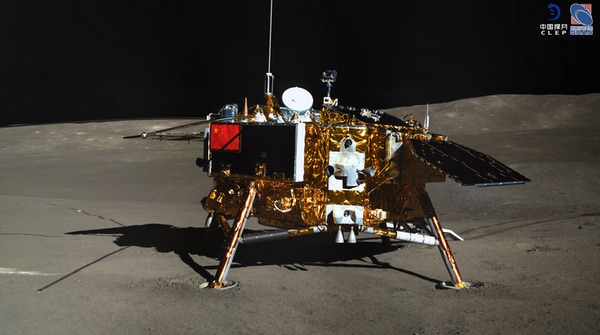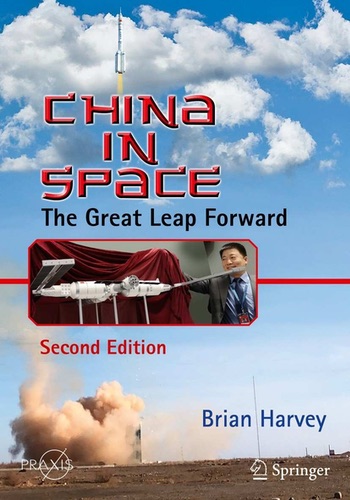Review: China in Spaceby Dwayne A. Day
|
| As Harvey explains it, China is developing substantial space infrastructure to support a range of activities, but as yet there is no clear indication that China has set its sights on a human Moon landing. |
Harvey begins the book with the discussion of the Chang’e-4 mission that landed on the lunar farside in 2019 as well as China’s first crewed space station, planned to become at least partly operational soon. The lunar mission represents a unique achievement for the country, since there have been no other landings on the lunar farside. But compared to the early space age, when the accomplishment of “firsts” was a key driver for the United States and Soviet Union, China has different ambitions. China has by now demonstrated a methodical, building-block approach to robotic lunar missions that has resulted in the development of some impressive capabilities.
Harvey also discusses China’s long-term objectives in human spaceflight which, for at least the next decade, focus on a long-duration space station in Earth orbit. As Harvey explains it, China is developing substantial space infrastructure to support a range of activities, but as yet there is no clear indication that China has set its sights on a human Moon landing, although it certainly is acquiring the engineering expertise and operational experience necessary for such a mission.
 The Chang’e-4 lander on the lunar surface. (credit: CLEP) |
After opening the book with a discussion of China’s current plans and activities, Harvey then turns to the history of how China has gotten to this point in time. In the 1950s, China began its missile program under the leadership of Tsien Hsue Shen, who had been trained in the United States and worked at Caltech, but was badly treated by the US government. Tsien’s history in the United States is complex and ambiguous. As the late Iris Chang wrote in her excellent book Thread of the Silkworm, Tsien had decided to return to his homeland when he was accused of being a communist agent, something that was almost certainly untrue. He was detained in the United States, which may have changed his attitude against the country that up to then had treated him well. He was released due to lack of evidence against him, and upon reaching China, he was given the opportunity to conduct missile research for the Communist government, eventually developing more powerful missiles and China’s nascent space program. (See: “A Dragon in winter,” The Space Review, January 14, 2008.) Under Tsien’s leadership, China launched its first artificial satellite in April 1970.
Harvey devotes chapters of his book to rockets, science and technology, communications, applications and military programs, human spaceflight, and Moon and Mars missions. His final chapter seeks to place China in the context of global space activities. China has its own unique approach to space: it studies the space programs of Russia and the United States—even stealing their designs when possible—but applies its own engineering talents to developing Chinese hardware. Those who dismissively claim that China copies the space hardware of other countries ignore the fact that China has many smart scientists and engineers, many of them educated in top Western schools like MIT and Stanford. In recent decades, China has sought to reverse the brain drain of its smartest scientists and engineers who headed to the West for higher education and then stayed there because of greater economic opportunities. The Chinese government has offered lucrative incentives to bring its highly-educated citizens back home where they have gone to work in various industries, including the space program.
Throughout the past few decades, it has been common for Westerners with agendas of their own to portray China’s civilian space program as something that it never was. When it was first revealed in the late 1990s that China had a human spacecraft program in the works, various Western observers claimed that China was about to “seize the high ground” with its Shenzhou spacecraft. But since the launch of Yang Liwei in October 2003, there have been only five more crewed launches, the last in 2016.
| China wants to use space, and to be recognized as a space power, but it is not pursuing fantastical goals of establishing an off-world economy. |
Six launches in 17 years has been a far slower pace than even the most levelheaded analysts of the Chinese program would have predicted. Yet even today non-Chinese observers make fantastical claims that China is planning to build a base on the Moon, mine lunar ice, even harvest helium-3 for nonexistent fusion reactors and begin construction of massive space solar power satellites—claims that are based upon the thinnest sources. These warnings of imminent Chinese acquisition of the Moon have captured the attention of some in the American military, but so far, they have not gained broad acceptance.
Current events offer another example. In two months, China will most likely launch a robotic lunar sample return mission that was first announced in the mid-2000s. That mission, Chang’e-5, was originally scheduled for 2017 and is therefore three years behind schedule. But it was common for non-Chinese writers in the 2000s to claim that this was going to be a human mission to the lunar surface. It never was, but the exaggeration was often intended to try to spur American action.
As a country that developed its space program later than the US and Soviet Union, China had fewer “firsts” to strive for, and instead chose to focus on capabilities rather than propaganda feats. To the extent that the Chinese government extols its accomplishments, the primary audience appears to be a domestic rather than international one. But even so, China’s civil space ambitions do not appear to be greater than those of the United States, not by a long shot. China wants to use space, and to be recognized as a space power, but it is not pursuing fantastical goals of establishing an off-world economy. Harvey’s book explains how China has been pursuing its space program for its own ends, not to meet the expectations of Westerners.
Note: we are temporarily moderating all comments submitted to deal with a surge in spam.
